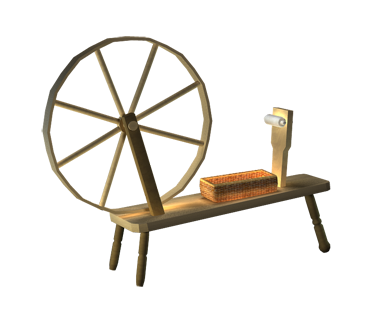Object Descriptions Ground Floor Parlor
Spinning Wheel
Spenser’s second wife, Elizabeth Boyle, would likely have lived at Kilcolman with him from the time they married, on June 11, 1594 (the date identified in his wedding poem, “Epithalamion”). If so, she would have managed many aspects of the household and performed domestic tasks there. She may also have prepared food and been in charge of any gardens on the estate.
One main industry of housewives at the time was to spin yarn out of clumps of wool. We do not know if Boyle would have done this or would have left such work to her servants. Spinning was considered “women’s work” and there was plenty of wool to spin at Kilcolman: pastoral by-products such as wool and leather were economic staples of the Munster plantation.
Another spinning product was linen. Linen was widely worn in Ireland but manufactured there only in limited quantities in the sixteenth century. The industry grew by leaps and bounds in later centuries, however, particularly in the north.

Literary Connections
While spinning by the warmth of the fire, a woman might gossip, share news or tell fantastic “old wives’ tales,“ including literary ones.
Spinning activity appears in Spenser’s poetry. In Book V of The Faerie Queene, the Amazon Radigund defeats Artegall, the hero of Justice. Radigund dresses him in an apron and “womans weeds” (V.v.20.7) and places him into a “long large chamber” (V.v.21.3) with many other male captives to spin linen (not wool) yarn:
There entred in, he round about him saw
Many braue knights, whose names right well he knew,
There bound t’obay that Amazons proud law,
Spinning and carding all in comely rew,
That his bigge hart loth’d so vncomely vew.
But they were forst through penurie and pyne,
To doe those workes, to them appointed dew:
For nought was giuen them to sup or dyne,
But what their hands could earne by twisting linnen twyne.Amongst them all she placed him most low,
And in his hand a distaffe to him gaue,
That he thereon should spin both flax and tow;
A sordid office for a mind so braue.
So hard it is to be a womans slaue.… (FQ V.v.22-3)
Artegall is modeled allegorically, in part, on Arthur, Lord Grey, Lord Deputy of Ireland from 1580-82 and Spenser’s patron there during those years. Spenser thought that Grey’s efforts at hard-line reform in Ireland were frustrated by backbiting enemies at court and by the English government’s vacillating and conciliatory policies towards the Irish. The Queen, from Spenser’s point of view, was prone to compromise, change policy and be too merciful towards her enemies. She was also stingy (or financially prudent to a fault). Various court factions were able to take advantage of her fickle behavior in this regard and thereby frustrate Grey’s reforms. At the time, a changeful mind and excessive mercy were seen as womanly weaknesses, shared by the queen. By contrast, Grey, a hard-liner, was not allowed to be “manly” enough for long enough to thoroughly reform the country.
Some critics see this dilemma acted out allegorically in the above passage. Artegall, a.k.a. Lord Grey, and other brave knights have been reduced to effeminate captivity (spinning linen) thanks to the queen’s interference in and obstruction of their efforts at reforms in Ireland. In this case Radigund represents a negative allegorical portrayal of the Queen, who virtually emasculates her would-be warriors.
In Spenser’s prose tract, A View of the Present State of Ireland, Irenius describes the native Irish custom of women directing “all things, both at home and in the fields,” a custom supposedly picked up from their Spanish (Gaulish) ancestry. Irenius states this immediately after noting the Irish custom of wearing shirts and smocks colored with saffron, a habit which also came from Spain: such Spanish shirts are made of linen (View 61).
Bibliography:
Judith H. Anderson, “Artegall.” The Spenser Encyclopedia. Ed. A. C. Hamilton (Toronto: U of Toronto P, 1990), 62-4.
Andrew Hadfield, Edmund Spenser: A Life (Oxford: Oxford UP, 2012): 220-221, 325.
Mary Ellen Lamb, The Popular Culture of Shakespeare, Spenser and Jonson (NY: Routledge 2006), esp. ch.’s 3 and 7.
Willy Maley, Salvaging Spenser: Colonialism, Culture and Identity (London: Macmillan, 1997): 87-88.
Gervase Markham, The English Housewife. Ed. Michael R. Best (Montreal: McGill-Queen’s UP, 1986).
M. McAuliffe, “The lady in the tower: the social and political role of women in tower houses.” The Fragility of Her Sex? Medieval Irish women in their European context. Ed. C.E. Meeks and M.K. Simms (Dublin, Four Courts Press: 1996), 153-62.
Richard McCabe, Spenser’s Monstrous Regiment: Elizabethan Ireland and the Poetics of Difference (Oxford: Oxford UP, 2002).
Andrew Murphy, But the Irish Sea Betwixt Us: Ireland, Colonialism, and Renaissance Literature (Lexington, KY: UP of Kentucky, 1999): 82-5.
Carol Schreier Rupprecht, “Radigund.” The Spenser Encyclopedia. Ed. A. C. Hamilton (Toronto: U of Toronto P, 1990), 580-1.